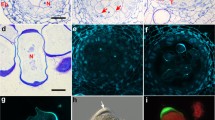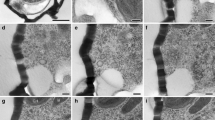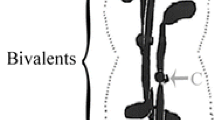Summary
Basal bodies in embryophyte spermatozoids develop from centrosomes which arisede novo in spermatid mother cells (SMC). The centrosomes at SMC spindle poles in those land plants producing biflagellated sperms comprise a coaxial pair of centrioles, a bicentriole (BC). Ultrastructural observations of antheridia of the aquatic liverwortRiella americana indicate that the centrosome is first evident as a dark staining body on the outer surface of the nucleus. Numerous short microtubules (MT) diverge from this body which next separates into two lobes, each with divergent MTs. Within each lobe, a BC differentiates-the cartwheel hub and spokes developing before the triplet MTs. Constituent centrioles of each BC are apposed by their proximal ends and connected only by the central hub. As the BCs migrate toward opposite spindle poles, they appear to be connected by MTs that terminate in granular material partially investing each BC. Each spermatid resulting from SMC division will inherit a bicentriole.
Similar content being viewed by others
References
Anderson, R. G. W., Brenner, R. M., 1971: The formation of basal bodies (centrioles) in the Rhesus monkey oviduct. J. Cell Biol.50, 10–34.
Carothers, Z. B., 1975: Comparative studies on spermatogenesis in bryophytes. In: The biology of the male gamete (Duckett, J. G.,Racey, P. A., eds.), Biol. J. Linn. Soc.7, Suppl.1, pp. 71–84.
Dirksen, E. R., 1971: Centriole morphogenesis in developing ciliated epithelium of the mouse oviduct. J. Cell Biol.51, 286–302.
Duckett, J. G., 1975: Spermatogenesis in pteridophytes. In: The biology of the male gamete (Duckett J. G.,Racey, P. A., eds.), Biol. J. Linn. Soc.7, Suppl.1, pp. 97–127.
Dustin, P., 1978: Microtubules. Berlin-Heidelberg-New York: Springer.
Gifford, E. M., Jr., Larson, S., 1980: Developmental features of the spermatogenous cell inGinkgo biloba. Amer. J. Bot.67, 119–124.
—,Lin, J., 1975: Light microscope and ultrastructural studies of the male gametophyte inGinkgo biloba: the spermatogenous cell. Amer. J. Bot.62, 974–981.
Hepler, P. K., 1976: The blepharoplast ofMarsilea: itsde novo formation and spindle association. J. Cell Sci.21, 361–390.
Klekowski, E. J., Jr., Hickok, L. G., 1979: Ultrastructural, studies of mutant spermatozoids in ferns. 1. The mature nonmotile spermatozoid of mutation 230 × inCeratopteris thalictroides (L.) Brongn. Gamete Research2, 317–343.
Lepper, R., Jr., 1956: The plant centrosome and the centrosome-blephharoplast homology. Bot. Rev.22, 375–417.
Melkonian, M., 1982: Structural and evolutionary aspects of the flagellar apparatus in green algae and land plants. Taxon31, 255–265.
Mizukami, I., Gall, J., 1966: Centriole replication II. sperm formation in the fern,Marselea, and the cycad,Zamia. J. Cell Biol.29, 97–111.
Moser, J. W., Kreitner, G. L., 1970: Centrosome structure inAnthoceros laevis andMarchantia polymorpha. J. Cell Biol.44, 454–458.
Norstog, K., 1981: Spermatogenesis inZamia (Cycadales). Bot. Soc. Amer. Misc. Ser. Pub.160, 16.
Paolillo, D. J., 1974: Motile male gametes of plants. In: Dynamic aspects of plant ultrastructure (Robards, A. W., ed.), pp. 504–531. London: McGraw-Hill.
Perkins, F. O., 1970: Formation of centriole and centriole-like structures during meiosis and mitosis inLabyrinthula sp. (Rhizopodea, Labyrinthulida). J. Cell Sci.6, 629–653.
Pickett-Heaps, J. D., 1968: Ultrastructure and differentiation inChara (fibrosa). IV. Spermatogenesis. Australian J. biol. Sci.21, 655–690.
Pickett-Heaps, J. D., 1969: The evolution of the mitotic apparatus: an attempt at comparative ultrastructural cytology in dividing plant cells. Cytobios3, 257–280.
—, 1971: Reproduction by zoospores inOedogonium. I. Zoosporogenesis. Protoplasma72, 275–314.
Robbins, R. R., Carothers, Z. B., 1975: The occurence and structure of centrosomes inLycopodium complanatum. Protoplasma86, 279–284.
— —, 1978: Spermatogenesis inLycopodium: the mature spermatozoid. Amer. J. Bot.65, 433–440.
Robert, D., 1982: Les gamétes mâles mobiles chez les végétaux supérieurs (Archégoniates). Année Biol.21, 1–35.
Roos, U.-P., 1975: Fine structure of an organelle associated with the nucleus and cytoplasmic microtubules in the cellular slime mouldPolysphondylium violaceum. J. Cell Sci.18, 315–326.
Turner, F. R., 1966: Changes in cellular organization during spermatogenesis. Ph.D. diss., University of Texas, Austin.
—, 1971: The effects of colchicine on spermatogenesis inNitella. J. Cell Biol.46, 220–234.
Vaudois, B., Tourte, Y., 1979: Spermatogenesis in a pteridophyte 1. First stages of the motile apparatus. Cytobios24, 143–156.
Wheatley, D. N., 1982: The centriole: A central enigma of cell biology. Amsterdam: Elsevier.
Author information
Authors and Affiliations
Rights and permissions
About this article
Cite this article
Robbins, R.R. Origin and behavior of bicentriolar centrosomes in the bryophyteRiella americana . Protoplasma 121, 114–119 (1984). https://doi.org/10.1007/BF01279757
Received:
Accepted:
Issue Date:
DOI: https://doi.org/10.1007/BF01279757




